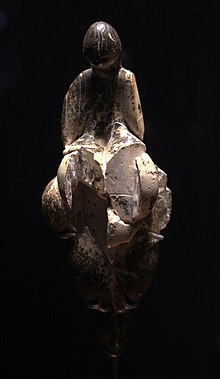
The Venus of Willendorf is an 11.1-centimetre-tall (4.4 in) Venus figurine estimated to have been made c. 30,000 years ago. It was recovered on 7 August 1908 from an archaeological dig conducted by Josef Szombathy, Hugo Obermaier, and Josef Bayer at a Paleolithic site near Willendorf, a village in Lower Austria. The figurine was found by a workman named either Johann Veran or Josef Veram and is carved from an oolitic limestone that is not local to the area, and tinted with red ochre. It is in the Natural History Museum in Vienna, Austria as of 2003.

The Venus of Dolní Věstonice is a Venus figurine, a ceramic statuette of a nude female figure dated to 31,000–27,000 years ago. It was found at the Paleolithic site Dolní Věstonice in the Moravian basin south of Brno, in the base of Děvín Mountain in what is today the Czech Republic. This figurine and a few others from locations nearby are the oldest known ceramic articles in the world.

A Venus figurine is any Upper Palaeolithic statue portraying a woman, usually carved in the round. Most have been unearthed in Europe, but others have been found as far away as Siberia and distributed across much of Eurasia.

The Aurignacian is an archaeological industry of the Upper Paleolithic associated with Early European modern humans (EEMH) lasting from 43,000 to 26,000 years ago. The Upper Paleolithic developed in Europe some time after the Levant, where the Emiran period and the Ahmarian period form the first periods of the Upper Paleolithic, corresponding to the first stages of the expansion of Homo sapiens out of Africa. They then migrated to Europe and created the first European culture of modern humans, the Aurignacian.

The Gravettian was an archaeological industry of the European Upper Paleolithic that succeeded the Aurignacian circa 33,000 years BP. It is archaeologically the last European culture many consider unified, and had mostly disappeared by c. 22,000 BP, close to the Last Glacial Maximum, although some elements lasted until c. 17,000 BP. In Spain and France, it was succeeded by the Solutrean and by the Epigravettian in Italy, the Balkans, Ukraine and Russia.

The Venus of Brassempouy is a fragmentary ivory figurine from the Upper Palaeolithic, apparently broken from a larger figure at some time unknown. It was discovered in a cave at Brassempouy, France in 1894. About 25,000 years old, it is one of the earliest known realistic representations of a human face.
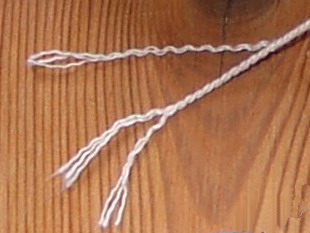
Twine is a strong thread, light string or cord composed of string in which two or more thinner strands are twisted, and then twisted together (plied). The strands are plied in the opposite direction to that of their twist, which adds torsional strength to the cord and keeps it from unravelling. This process is sometimes called reverse wrap. The same technique used for making twine is also used to make thread, which is thinner, yarn, and rope, which is stronger and thicker, generally with three or more strands.

Dolní Věstonice is an Upper Paleolithic archaeological site near the village of Dolní Věstonice in the South Moravian Region of the Czech Republic, at the base of Mount Děvín, 550 metres (1,800 ft). It dates to approximately 26,000 BP, as supported by radiocarbon dating. The site is unique in that it has been a particularly abundant source of prehistoric artifacts dating from the Gravettian period, which spanned roughly from 27,000 to 20,000 BC. In addition to the abundance of art, this site also includes carved representations of men, women, and animals, along with personal ornaments, human burials and enigmatic engravings.

Paleolithic religions are a set of spiritual beliefs and practices that are theorized to have appeared during the Paleolithic time period. Paleoanthropologists Andre Leroi-Gourhan and Annette Michelson believe unmistakably religious behavior emerged by the Upper Paleolithic, before 30,000 years ago at the latest, but behavioral patterns such as burial rites that one might characterize as religious — or as ancestral to religious behavior — reach back into the Middle Paleolithic, as early as 300,000 years ago, coinciding with the first appearance of Homo neanderthalensis and possibly Homo naledi.

The Venus of Hohle Fels is an Upper Paleolithic Venus figurine made of mammoth ivory that was unearthed in 2008 in Hohle Fels, a cave near Schelklingen, Germany, part of the Caves and Ice Age Art in the Swabian Jura UNESCO World Heritage Site. It is dated to between 42,000 and 40,000 years ago, belonging to the early Aurignacian, at the very beginning of the Upper Paleolithic, which is associated with the earliest presence of Cro-Magnons in Europe.

The Mal'ta–Buret' culture is an archaeological culture of the Upper Paleolithic. It is located roughly northwest of Lake Baikal, about 90km to the northwest of Irkutsk, on the banks of the upper Angara River.

The Venus of Moravany is a small prehistoric Venus figurine discovered in Slovakia in the early 20th century.
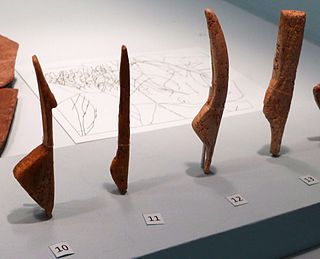
The Venus figurines from Gönnersdorf, at Neuwied, are paleolithic sculptures depicting the female body.
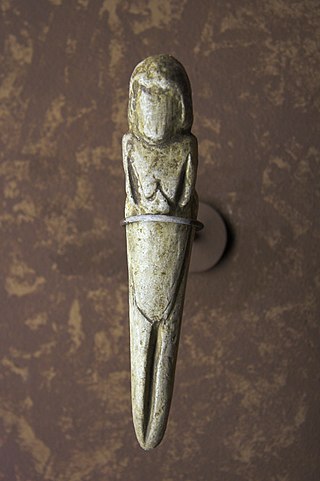
The Venus figurines of Mal’ta are several palaeolithic female figurines of the Mal'ta–Buret' culture, found in Siberia, Russia.

The Vénus impudique is the first Paleolithic sculptural representation of a woman discovered in modern times. It was found by Paul Hurault, 8th Marquis de Vibraye in about 1864 at the famous archaeological site of Laugerie-Basse in the Vézère valley.
Venus of Buret' may refer to any of the five Venus figurines found from archeological site of Buret' in Siberia near Irkutsk and the Angara river valley.

The Venus figurines of Gagarino are eight Palaeolithic Venus figurines made from ivory. The statuettes belong to the Gravettian industry and are about 21,000–20,000 years old. They were discovered near to the village of Gagarino in Lipetsk Oblast, Russia, and are now held in the Hermitage Museum in Saint Petersburg.

The Venus figurines of Balzi Rossi from the caves near Grimaldi di Ventimiglia (Italy) are thirteen Paleolithic sculptures of the female body. Additionally, two small depictions of the human head were discovered at the same place. The age of these figurines cannot be determined because of missing archaeological context data. It is usually accepted that these figurines stem from the Gravettian, about 24,000 to 19,000 years old. Most of the sculptures consist of steatite and are between 2.4 and 7.5 cm in height. Between 1883 and 1895, the figurines were discovered by the antique dealer Louis Alexandre Jullien at the cave complex Balzi Rossi at the Ligurian coast. Eight of these sculptures are housed in the museum Saint-Germain-en-Laye near Paris.
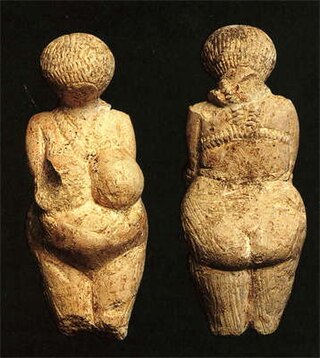
The Venus figurines of Kostenki are prehistoric representations of the female body, usually in ivory and usually dated to between 25,000 and 20,000 years ago, making them part of the Gravettian industry of the Upper Palaeolithic period. Found in the Kostyonki-Borshchyovo archeological complex in Russia, these Venus figurines are now in the Hermitage Museum.
